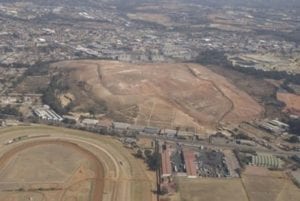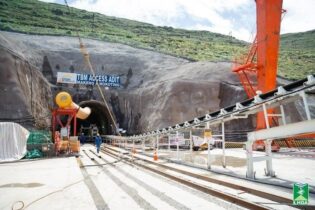A major focus on environmental compliance was at the heart of the construction and commissioning of a contaminated water management system at Robinson Deep Landfill Site in Johannesburg, which was completed at the end of August 2013, says Mzukisi Tshem, Pikitup general manager: Disposal.
At the time of the interview, Tshem noted that the programme tracking outlined that the project was running late by a day at that stage, “which may still be recovered.” Construction commenced in April this year. The project itself though stands out from the rest, according to Tshem, not only because it looks set to meet projected construction timelines, but because “this project is going to ensure compliance to environmental practices associated with the site.” The improvement of run-off water management at the site is significant, says Tshem, because this will improve operational compliance at the site significantly. “When the site complies with its permit conditions, the negative impact to the surrounding environment is reduced drastically and it becomes socially acceptable to the community within which it operates, ”explains Tshem, adding that buy-in and cooperation with the community within which the site is operated will sustain its existence. Pikitup is the custodian of the project. “We are the landfill site permit holder and therefore we need to ensure compliance to the operating permit conditions. It is a permit requirement and best practice to ensure that all water run-off associated with the site is managed in a manner that is not detrimental to the surrounding environment and to ensure landfill compliance to its operating permit conditions,” states Tshem. Project background As the landfill progressively develops, it is required that ongoing infrastructure development and maintenance keep up with the development to ensure compliance to its operating permit conditions. “Over the years of operation, the existing pond at the site had silted up due to run-off at the site during wet weather conditions,” he continues. Tshem adds that on the other hand, the site development was progressing, which warranted that the pond be de-silted and enlarged to accommodate contaminated run-off generated by the site. “To achieve this, the contaminated water catchment drainage system leading to the pond has to be upgraded to avoid continuous ponding at the site during rainy season and to ensure that a compliant water management system is maintained.” A phased approach According to Tshem, a phased approach has been adopted in implementing the required works to support the progressive development of the site and to ensure full compliance. The current phase involves the following:- de-silting and expansion of the existing contaminated water management pond
- upgrading of part drainage system associated with the pond and site run-off water management
- walling/fencing around the pond and the northern boundary of the site where construction activities are taking place
- regrading and or shaping of the northern site terrain to enhance controlled water run-off
- construction of part ring road around the site, to enable easy access.
Contractor’s contribution
According to Justin Butt of Fountain Civil Engineering (FCE), the main contractor for the project, the contaminated stormwater and leachate system at the landfill was unable to cope and needed rehabilitation and upgrading as all the pollutants were being allowed to flow uncontrolled into a large unlined pond adjacent to the landfill. “This project was commissioned in order to contain the situation and get the contaminated stormwater under control,” explains Butt. Butt says the importance of getting the right drainage system in place cannot be underestimated, as this aspect is vital to the job in order to stop erosion of the rehabilitated sections of the landfill and unwanted ponding of water in the area. He adds that the scope of the project included firstly pumping out the existing stormwater pond, secondly de-silting the pond to increase capacity, then rehabilitating and reshaping the area through a cut-and-fill process,followed by hydroseeding (grassing) the area, before finally building new stormwater drains to protect the landscape. “As the main contractor, FCE wasresponsible for carrying out all the earthworks and concrete works.FCE has extensive landfill experience, having worked on all the different aspects of landfill construction, closure and leachate management in the past. We have previously carried out contracts at Robinson Deep Landfill, and so were aware of the daily operations of the site, and the site management personnel,” says Butt. According to Butt, one of the greatest challenges on-site, was cleaning out and de-silting the stormwater pond as it was extremely muddy. “Our plant was unable to drive on the material to dredge out the pond-making working conditions difficult and slow,” says Butt. This challenge was overcome by creating an access road by importing stable rock material. “This enabled our plant to gain access to the sludge in the middle of the pond for removal.” For Butt, the highlight of the project was seeing the change in landscape, “from an unruly stockpile of material to a nice flat grassed area.” A challenging context According to Tshem, some of the challenges faced in the roll-out of the project includedflooding on-site during the rainy season and insufficient suitable cover material. These challenges were, however, easily overcomeby implementing the site run-off water management designs and by sourcing cover material from external sources, i.e. mine dumps and abandoned soil spoils. Part of the project, however, that was not as easily seen due to its intricate nature was the de-silting of the pond. “The de-silting of the pond is quite a challenging operation as machines/plant is required to operate in the mud, which may sink the machine. But experienced contractors with suitable equipment and technique were brought on board to conduct the complicated operation,” says Tshem, adding that large excavators and articulated dump trucks were roped in and temporary earth platforms were created to stabilise the pond in order to gain access and de-silt the pond. “As landfill technology evolves, Pikitup is taking all the opportunity at its disposal to engage specialists in the field and to explore alternative methods of conducting landfill operations. With landfill operations, there is always room for employing innovative technologies to enhance or improve compliance and ensure best practice,” concludes Tshem.







